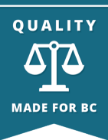If you disagree with a decision
If you think the tribunal’s decision was unfair or that the decision-maker made an error, there are ways to have the case reviewed. Sometimes tribunals will have internal review processes set out in the statute that creates them. If there is none, or if all internal review has been exhausted, a party may be able to apply to have the Courts to review the tribunal’s decision. The process is called “judicial review”.
Judicial Review
 Judicial review is when a judge reviews the decision of another legal-decision maker, such as a tribunal, for significant errors or unfairness. Judicial review happens in Supreme Court, in front of a Supreme Court judge. Judicial review is not the same as an appeal. Usually the court will only intervene where they find the tribunal made an error in law, made a decision outside its jurisdiction, demonstrated bias, did not follow the proper procedures, or made a decision that does not reasonably flow from the evidence.
Judicial review is when a judge reviews the decision of another legal-decision maker, such as a tribunal, for significant errors or unfairness. Judicial review happens in Supreme Court, in front of a Supreme Court judge. Judicial review is not the same as an appeal. Usually the court will only intervene where they find the tribunal made an error in law, made a decision outside its jurisdiction, demonstrated bias, did not follow the proper procedures, or made a decision that does not reasonably flow from the evidence.
If the tribunal’s decision touches on constitutional issues or issues of central importance to the legal system, the courts are more likely to step in to make sure the decision is “correct”. Otherwise, as long as the tribunal’s decision is not unfair or unreasonable, the courts will likely leave the decision alone.
The courts will not make their own decision on the original matter that was in front of the tribunal. Instead, they will usually just send the matter back to the tribunal to make another decision.











